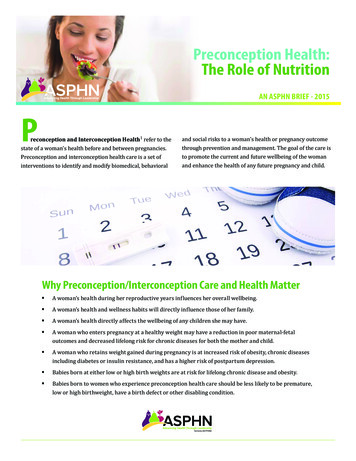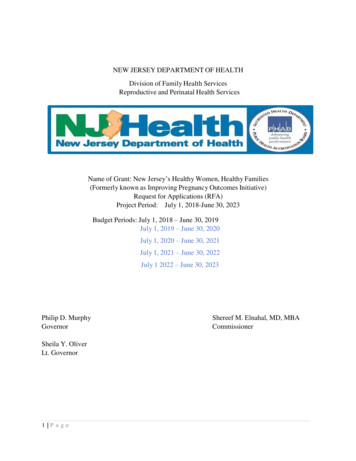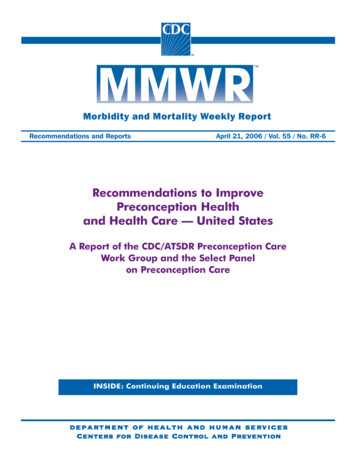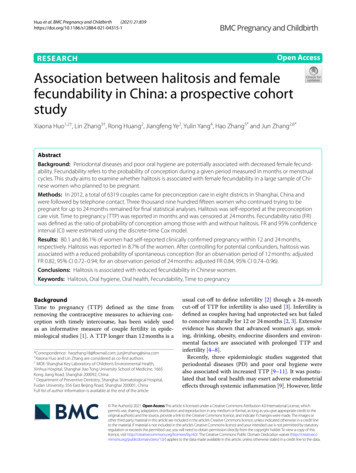
Transcription
Preconception Health:The Role of NutritionAN ASPHN BRIEF - 2015Preconception and Interconception Health1 refer to thestate of a woman’s health before and between pregnancies.Preconception and interconception health care is a set ofinterventions to identify and modify biomedical, behavioraland social risks to a woman’s health or pregnancy outcomethrough prevention and management. The goal of the care isto promote the current and future wellbeing of the womanand enhance the health of any future pregnancy and child.Why Preconception/Interconception Care and Health Matter A woman’s health during her reproductive years influences her overall wellbeing. A woman’s health directly affects the wellbeing of any children she may have. A woman’s health and wellness habits will directly influence those of her family.A woman who enters pregnancy at a healthy weight may have a reduction in poor maternal-fetaloutcomes and decreased lifelong risk for chronic diseases for both the mother and child.A woman who retains weight gained during pregnancy is at increased risk of obesity, chronic diseasesincluding diabetes or insulin resistance, and has a higher risk of postpartum depression.Babies born at either low or high birth weights are at risk for lifelong chronic disease and obesity.Babies born to women who experience preconception health care should be less likely to be premature,low or high birthweight, have a birth defect or other disabling condition.
— Preconception Health: The Role of Nutrition —IntroductionWomen need access to preventive and clinical care during their reproductive years for their ownwellbeing and for children they may have. This includes attention to dietary adequacy, healthyweight and any medical nutrition therapy and preventive nutrition needs. This brief addressesboth public health and clinical aspects of preconception and interconception health for women.It also focuses on delineating the role of nutrition and nutrition professionals in providingpreconception health and health care. To simplify terminology, the term preconception will beused for both preconception and interconception periods.Preconception Health and Health CareAbout 30 years ago, concerned professionals began lookingat improving poor pregnancy outcomes by addressing thehealth status of women prior to pregnancy. This framework,known as preconception care, consists of related activitiesthat focus on the primary prevention of many poorpregnancy outcomes, such as congenital anomalies, whichare difficult or impossible to alter once a woman is pregnant.Preconception care also provides a timely opportunity topositively influence factors associated with poor pregnancyoutcomes, such as interconception length, chronic diseasecontrol and unintended conception. 2Over time, this approach has become more common. TheCenters for Disease Control and Prevention (CDC) considerspreconception health3 as the health of women (and men)within their reproductive years encompassing high levels ofwellness. This approach includes taking steps now to protectthe health of a baby a woman might have sometime in thefuture. However, all women can benefit from preconceptionhealth, regardless of pregnancy intention. 2 Preconception Health: The Role of NutritionThe concepts underpinning preconception health are basedupon those associated with promoting good health. Thepublic health goal in addressing preconception health isto create environments where it is easy for women to behealthy. This is done by enhancing factors associated withgood health (e.g. access to health care) and reducing thosethat have a negative influence (e.g. smoking). It includesliving in an environment with clean air; engaging in healthpromoting behaviors such as physical activity and heathyeating; and providing the knowledge and resources neededto plan pregnancies. Preconception health and health carerequire multiple, sustainable interventions that occurconcurrently to improve overall women’s health. Changesare needed in policy, systems and environment, as well as inclinical practice for preconception health to befully realized.It is important that all women have access to preconceptioncare as part of routine health encounters. The goal is tointegrate preconception care concepts into clinical careAssociation of State Public Health Nutritionists
— Preconception Health: The Role of Nutrition —and make it widely available, so that women ask for thiscare, providers offer it and insurers reimburse for services.Preconception care is the clinical care a woman receivesthat addresses those factors known to increase the chancesof having a healthy baby, tailored to her specific needs. Thiscare includes health assessment and maintenance acrossthe life span addressing childbearing and contraceptiveconsiderations along with women’s general health concerns.An important component is reproductive life planning thatinvolves activities to help a woman plan, based on her valuesand resources, how to achieve personal goals about whetheror when to have children.4A challenge associated with preconception care isunintended pregnancy. According to the GuttmacherInstitute, 5 in the United States, about 51 percent or 3.4million pregnancies each year are unintended. MostAmerican families want two children and to achieve this,the average woman spends about five years pregnant,postpartum or trying to become pregnant. More than threequarters of her reproductive life is spent trying to avoid anunintended pregnancy.If a woman is unaware she is pregnant she cannot attendto the critical needs of the very early prenatal period.Unintended births are associated with adverse maternaland child health outcomes, such as delayed prenatal care,premature birth and negative physical and mental healtheffects for children. Low-income, cohabiting and minoritywomen aged 18–24 are the most likely to experience anunintended pregnancy6 and these are the women least likelyto receive preconception care.ResourcesThe National Preconception Health and HealthcareInitiative is a leader in promoting preconceptionhealth. The Initiative is a public-private partnershipwhich engages the United States Department of Healthand Human Services, Centers for Disease Control andPrevention (CDC) and the Health Resources ServicesAgency (HRSA), and other government agencies,nonprofit organizations, professional organizations andhundreds of individuals. This site offers informationfor women and men, tools for health professionals,reproductive life planning, surveillance indicators andmore. This group has led the effort to create policy,guidelines, tools and resources.As part of the National Preconception Health andHealthcare Initiative, the Before, Between and BeyondPregnancy website was established as a comprehensiveclinical resource. 3 Preconception Health: The Role of NutritionAssociation of State Public Health Nutritionists
— Preconception Health: The Role of Nutrition —Organizing FrameworksSupporting a PreconceptionHealth ApproachThe following are a set of theories that underpina preconception health approach to women’sand children’s health. Together they create anunderstanding about the multiple threads that leadto wellness and health; the role of the individual andother factors; and the elongated time frame inwhich supports and hindrances to health mustbe considered.Social Determinants of HealthThe Social Determinants of Health are economicand social conditions that influence the health of people andcommunities and are related to health outcomes. Accordingto the Centers for Disease Control and Prevention (CDC)7,addressing social determinants of health is a primaryapproach to achieving health equity. The determinants ofhealth are factors that contribute to a person’s current stateof health. These factors may be biological, socioeconomic,psychosocial, behavioral, or social in nature. Theoretically,genes, biology, and health behaviors together accountfor about 25 percent of population health. The otherapproximately 75 percent of population health is influencedby the social determinants of health that include: socialenvironment (such as discrimination, gender, or income),physical environment/total ecology, and health services/medical care.Life Course TheoryPreconception care is also consistent with Life CourseTheory (LCT). According to the Maternal and Child HealthBureau, 8 LCT is a conceptual framework that helps explainhealth and disease patterns, particularly health disparities,across populations and over time. LCT is population focused,and firmly rooted in social determinants and social equitymodels. This theory hypothesizes that birth outcomesare impacted by the long-term interaction of a woman’sbiology, behavior, psychology and the social/environmentalprotective factors (e.g. healthy eating) and risk factors (e.g.inadequate folic acid intake). 4 Preconception Health: The Role of NutritionThere is an intergenerational effect where the health ofone generation affects the health of the next. Maintaining awoman’s health prior to and between pregnancies is entirelyconsistent with this approach, recognizing that the healthof the mother and child cannot totally be separated. Whileinterconception care is traditionally viewed as short-term,LCT treats this time frame as open-ended beginning withthe end of one pregnancy and ending only after the nextconception has been diagnosed or the woman is no longerable to conceive.Fetal Origins HypothesisThe Fetal Origins Hypothesis (also known as theBarker Hypothesis) amplifies the importance of nutritionthroughout the life course of a woman and her child.Evidence links adverse exposures in early life to chronicdisease susceptibility in adulthood. Nutrition is a majorintrauterine environmental factor that alters expressionof the fetal genome and may have lifelong consequences.These changes may result in increased incidence of certaindiseases such as obesity, high blood pressure and heartdisease in adulthood. Promoting optimal nutrition not onlyensures optimal fetal development, but will also reducethe risk of chronic diseases in adults.9 Studies show thatboth over and under nutrition have detrimental effects onthe child’s risk of adult diseases including propensity forobesity. Also, too much and too little intake of nutrients canalter fetal programming.Association of State Public Health Nutritionists
— Preconception Health: The Role of Nutrition —Nutrition, Preconception Health and Health CareThe role of nutrition as part of good health, chronic diseaseand pregnancy outcomes is well established. Thus nutritionis recognized as a component of preconception healthand health care. Nutrition has both clinical and publichealth aspects. The clinical aspect requires working withindividuals about their diet, habits, weight and overallhealth. The public health aspect addresses creatingenvironments where healthy eating is the easy choice.Creating these environments is built on policy, systems andenvironmental change efforts.Three areas emerge when considering the role of nutritionas part of preconception health. They are: dietary adequacy;achieving and maintaining a healthy weight; and nutritionas part of existing health care conditions.Dietary AdequacyAll women should be encouraged to consume nutrient-densefoods and beverages. Healthy eating has a two-fold aspect. Itis important for a woman’s health today and into the future.It is important for the health of the children as mothers areessential role models who purchase food, provide meals andmodel positive eating behavior.Many women need assistance in improving some aspectof their diet and need the knowledge and skills to makehealthier choices. A 2014 CDC, Morbidity and MortalityWeekly Report10 on preconception health indicated thatthe reported average consumption of adequate fruit andvegetable intake was 25 percent.Other social and physical factors that influence anindividual’s eating behaviors include: social support;societal and cultural norms; food and agricultural policies,food assistance programs; economic price systems; andaccess to and availability of healthier foods.11 From anenvironmental perspective, communities often needassistance making healthy food options available andaffordable, especially for vulnerable populations. Foodsecurity and eliminating hunger are important aspects.One noted nutrient during the preconception period isfolic acid. It has proven preventive properties againstneural tube defects such as anencephaly and spina bifida,which are among most common congenital anomalies.However, this protective effect is needed in the earlyweeks of pregnancy, long before many women knowthey are pregnant. A recent study of reproductive aged 5 Preconception Health: The Role of NutritionAll women should be encouraged to consumenutrient-dense foods and beverages.women12 reported only 30 percent of women reportedconsuming a folic acid supplement during the month priorto pregnancy. It is difficult to consume the RDA for folateduring pregnancy from dietalone thus supplementationand consumption of foodsfortified with folic acid arerecommended prior to andduring pregnancy. Women arealso encouraged to consumefoods rich in this nutrient.Association of State Public Health Nutritionists
— Preconception Health: The Role of Nutrition —Achieve and Maintain a Healthy WeightMaintaining a healthy weight is an importantrecommendation for all women of reproductive age.For the individual woman, interventions to improveweight are based on efforts to support a healthy lifestyleincluding healthy eating and physical activity. Again,factors associated with these efforts include: addressingindividuals’ knowledge and skills; reducing exposure tofoods low in nutritional value and high in calories; andincreasing opportunities for physical activity.13 Communitylevel activities include those that support efforts to maintainphysical activity, consume a healthy diet and provideinterventions when weight status is no longer at a healthylevel.Deviations from a healthy weight are of concern for botha woman and her future children. Pregnancy NutritionSurveillance System14 data indicate that one third of allpregnant women in America are obese. Half of non-pregnantwomen of child-bearing age (20-39) are either overweightor obese and 30 percent of girls between 12-19 years ofage are overweight or obese. Underweight also has healthconsequences. The highest prevalence of underweight isamong Asians and the highest prevalence of overweightand obesity is among Black, American Indian and Hispanicmothers.15 The following are some of the concernsassociated with under and overweight, especially duringpregnancy. Chronic health conditions associated with beingoverweight or obese are diabetes, coronary heartdisease, high blood cholesterol, stroke, hypertension,gallbladder disease, osteoarthritis, sleep apneaand other breathing problems and some cancers(endometrial, breast, colon). 16Being overweight or obese prior to pregnancy carriesrisks for both the mother and the fetus. Prepregnancyobesity is associated with infertility and miscarriage,as well as an increased risk of poor outcomes suchas prematurity, stillbirths and need for assisteddelivery.17, 18Obese women are less likely to initiate and sustainbreastfeeding.19Overweight and obesity prior to pregnancy is a riskfactor for spina bifida and cardiac defects. 20 6 Preconception Health: The Role of NutritionDeviations from a healthy weight are of concern forboth a woman and her future children. Underweight women are at increased risk of infertility.If pregnancy is achieved, their infants are at higherrisk for low birthweight, fetal growth problems,cleft lip, perinatal mortality and other pregnancycomplications. 21, 22It is best to support achieving a healthy weight priorto pregnancy. Adherence to the Institute of Medicine’spregnancy weight gain recommendations23 is encouragedonce a pregnancy is underway. After pregnancy, addressingpostpartum weight reduction is an important aspect ofinterconception care. Women often retain excess weightgained during pregnancy thus increasing the risk forentering a subsequent pregnancy at a higher weight. Thismay lead to an ongoing cycle resulting in obesity. Nearlyhalf of normal weight and two thirds of overweight womenhave been found to exceed the 1990 IOM gestational weightgain guidelines. 24 Women exceeding the guidelines haveAssociation of State Public Health Nutritionists
— Preconception Health: The Role of Nutrition —been shown in several studies to be at increased risk foradverse maternal and neonatal outcomes, and associationwith excessive gestational weight gain and postpartumweight retention. This is particularly true among womenwho are Black as well as from low socio-economic statusbackgrounds. Short interconception spacing, combined withhigh gestational weight gain, and four or more births areassociated with risk of obesity. 25, 26, 27, 29, 29Nutrition and Existing Health ConditionsThe role of nutrition in chronic illness such asdiabetes or hypertension must be addressed.The role of nutrition in chronic illness such as diabetes orhypertension must also be addressed. Women under medicalcare for chronic conditions such as diabetes, hypertensionand metabolic syndrome often require medical nutritiontherapy as part of their preconception and pregnancyclinical care. Acute conditions such as anemia are treatedwith diet and medication. Other conditions, like epilepsy andHIV infection, require medications that may alter nutritionalstatus. Some high-risk pregnancy conditions like pretermbirth, gestational diabetes or hypertension may reoccur insubsequent pregnancies. Several of these adverse healthconditions have a nutrition component, which should beaddressed between subsequent pregnancies.SummaryDietary quality, healthy weight and medicalnutrition therapy (for women with existinghealth conditions) are important components ofpreconception care, as they affect women’s shortand long-term health and future prenatal outcomes.Preconception nutrition topics include: enteringpregnancy at a healthy weight, dietary quality andthe use of folic acid. Post-partum nutrition effortsinclude: returning to a healthy weight, dietaryquality and support for breastfeeding. Medicalnutrition therapy must also be provided as part ofthe treatment for certain health conditions. 7 Preconception Health: The Role of NutritionAssociation of State Public Health Nutritionists
— PreconceptionHealth:TheNutritionistsRole of Nutrition —What PublicHealthCan Do to Support Preconception CareSupportin the and participdevelopment atepreconcofor at- eption servi frisk wocesencoumen aranuse th ge women dtese services. os andcy, systemliopaesUgeental chanenvironmrtk to supporowemafrsation care apreconcep f women’stocomponen healthn’sand childre.promotionndventions aretinedInclutheat addresshtseicvrsefl aspects onutritiona n health.tiopreconcepAddressqualit overall diety, weigaht stat ryincludinuweigh g postpartu st loss amnd encthe consoin fort umption of urageified fofolic acidosupplements ds and.entionsEnsure that intervuity andaddress health eqpetent.are culturally comProvidenutriti medicalon therapy aof treasptmhealth ent of rele artvantconcerns.Encouraat pos ge attendantpartucemmedical visit and othersproviders ab and askingout prtion/inecothealth erconceptio ncepncare. 8 Preconception Health: The Role of Nutrition 8 Preconception Health: The Role of NutritionAssociation of State Public Health Nutritionists
— Preconception Health: The Role of Nutrition —How Public Health Nutritionists Can AdaptWIC Programs’ Activities to Support Preconception CareWIC services can be adapted to reflect an interconceptionapproach that is culturally appropriate. Postpartum careis routine in WIC and by adopting a broader interpretation,an interconception approach may be incorporated. Bymore effectively assisting a woman to achieve high levels ofnutritional wellness WIC staff can influence her short andlong term health and the health of any future children. Consider using an interconception based approach topostpartum visits for every woman, regardless of herbreastfeeding status. Center education on the woman’sconcern about her health and possible subsequentpregnancies.Given the challenges associated with losing weightpostpartum, consider interventions in this area.Reinforce the importance of positive maternal healthhabits as she is the role model for family health. Ensure services are culturally appropriate.Assist the woman with prioritizing her interconceptionneeds.Discuss reproductive life planning and advise women toseek preconception care and contraception from healthcare provider; offer needed referrals.Discuss nutrition-related factors to address prior tonext pregnancy.Address ongoing medical nutrition therapy needs.Reinforce the need for being physically active every day.Emphasize avoiding smoking, alcohol and harmfulsubstances when planning next pregnancy.The following are some specific interventions: Integrate relevant elements of interconception care into existing programs and services.Highlight nutrition-related factors to addressprior to next pregnancy. 9 Preconception Health: The Role of NutritionAssociation of State Public Health Nutritionists
— Notes —1Minnesota Department of Health.Preconception and InterconceptionHealth page. ption.Retrieved April 2015.2Moos, MK, Bandura, M Posner SF, LuMC. Chapter 5: Quality ImprovementOpportunities in Preconception andInterconception Care. March of Dimes.Toward Improving the Outcomesof Pregnancy III. Pg. 46. IChapter5.pdf.3Centers for Disease Control andPrevention. Preconception Health andHealth Care. August 2014. http://www.cdc.gov/preconception/overview.html. Retrieved October 2015.4Moos, MK, Bandura, M Posner SF, LuMC. Chapter 5: Quality ImprovementOpportunities in Preconception andInterconception Care. March of Dimes.Toward Improving the Outcomes ofPregnancy III. Pg. 47. IChapter5.pdf. Retrieved April 2015.5Guttmacher Institute. UnintendedPregnancy in the US Fact Sheet. July2015. ancy-US.html Retrieved October 2015.6IBID7Centers for Disease Control and Prevention.Social Determinants of Health. March l. Retrieved April 2015.8U.S. Department of Health and HumanServices Health Resources and ServicesAdministration, Maternal and Child HealthBureau. Rethinking MCH: The Life CourseModel as an Organizing Framework.November, 2010. Pgs 2-3. ourse.pdf. Retrieved April 2015.9Wadhwa PD, Buss C, Entringer S,Swanson JM. Developmental Origins ofHealth and Disease: Brief History of theApproach and Current Focus on EpigeneticMechanisms. Semin Reprod Med. 2009September; 27(5): 358–368. 5/. Retrieved April 2015.10Robbins CL, Zapata, LB, Farr SL, et al. CoreState Preconception Health Indicators —Pregnancy Risk Assessment MonitoringSystem and Behavioral Risk FactorSurveillance System, 2009. 2014;63: (Pg.10). http://www.cdc.gov/mmwr/pdf/ss/ss6303.pdf. Retrieved April 2015.11Healthy People 2020. Nutritionand Weight Status. /topic/nutrition-and-weightstatus. Retrieved April 2015.12Robbins, CL, Zapata, LB. Farr, SL. Et al.PhD Core State Preconception HealthIndicators — Pregnancy Risk AssessmentMonitoring System and Behavioral RiskFactor Surveillance System, 2009. 2014;63:(Pg. 10). http://www.cdc.gov/mmwr/pdf/ss/ss6303.pdf. Retrieved April 2015.13Healthy People 2020. Nutritionand Weight Status. /topic/nutrition-and-weightstatus. Retrieved April 2015.14Chu SY, Kimm SY, Bish CL. PrepregnancyObesity Prevalence in the United States,2004–2005. JMCH. September 2009,Volume 13, Issue 5, pp 614-620.15IBID16National Academies of Sciences, Instituteof Medicine. Weight Gain During Pregnancy:Reexamining the Guidelines. Washington,DC: The National Academies Press, 2009.17Centers for Disease Control andPrevention. Healthy Weight HealthyPregnancy thyweight-healthy-pregnancy.html August2015. Retrieved October 2015.18Overcash RT, LaCoursiere DY. The clinicalapproach to obesity in pregnancy. ClinObstetrics Gynecolog. 2014;57(3): 485-500.19Rasmussen KM. Association ofmaternal obesity before conceptionwith poor lactation performance.Annu Rev Nutr. 2007;27:103-121.20Rasmussen, SA, Chu SY, Kim SY.Maternal obesity and risk of neural tubedefects: a metaanalysis. / Am J ObstetGynecol. 2008 Jun;198(6):611-9.21Centers for Disease Control andPrevention. Pregnancy and PediatricNutrition Surveillance System http://www.cdc.gov/pednss/what is/pnss health indicators.htm. March2011. Retrieved April 2015.22Waller, KD, Shaw GM, Rasmussen SA etal. Prepregnancy Obesity as a Risk Factorfor Structural Birth Defects Arch PediatrAdolesc Med. 2007;161(8):745-750.23National Academies of Sciences, Instituteof Medicine. Weight Gain During Pregnancy:Reexamining the Guidelines. Washington,DC: The National Academies Press, 2009.24Chu SY. Callaghan WM. Bish CL. D’Angelo D.Gestational weight gain by body mass indexamong US women delivering live births,2004–2005: Fueling future obesity. Am JObstet Gynecol. 2009; Mar; 200(3):271.e1-7.25Siega-Riz AM, Viswanathan M, MoosM-K, et al. A systematic review ofoutcomes of maternal weight gainaccording to the Institute of Medicinerecommendations: birthweight, fetalgrowth, and postpartum weight retention.Am J Obstet Gynecol 2009;201:339.e1-14.26Keppel KG, Taffel SM. Pregnancy‐relatedweight gain and retention: Implications ofthe 1990 Institute of Medicine guidelines.Am J Public Health 1993;83(8):1100‐3.27Davis EM, Babineau DC, Wang X, et al.Short inter-pregnancy intervals, parity,excessive pregnancy weight gain and riskof maternal obesity. Maternal and childhealth journal. 2014;18(3):554-562.28Harris HE, Ellison GT, Holliday M.Is there an independent associationbetween parity and maternal weight gain?Ann Hum Biol. 1997;24(6):507–19.29Olson CM, Strawderman MS, HintonPS et al. Gestational weight gain andpostpartum behaviors associated withweight change from early pregnancyto 1 y postpartum. Int J Obes RelatMetab Disord. 2003;27:117-127.This project was supported in part by the Health Resources andServices Administration, Maternal and Child Health Bureau(contract # T79MC00007) through a grant provided to theUniversity of Minnesota, School of Public Health. 12/8/2015Association of State Public Health NutritionistsP.O. Box 1001 Johnstown, PA 15907-1001[tel] 814.255.2829 [fax] 814.255.6514[web] www.asphn.org [facebook] www.facebook.com/asphn 10 Preconception Health: The Role of NutritionAssociation of State Public Health Nutritionists
As part of the National Preconception Health and . Healthcare Initiative, the Before, Between and Beyond Pregnancy website was established as a comprehensive clinical resource. — Preconception Health: The Role of Nutrition — and make it widely available, so that women ask for this . care, providers offer it and insurers reimburse for services.File Size: 915KB










